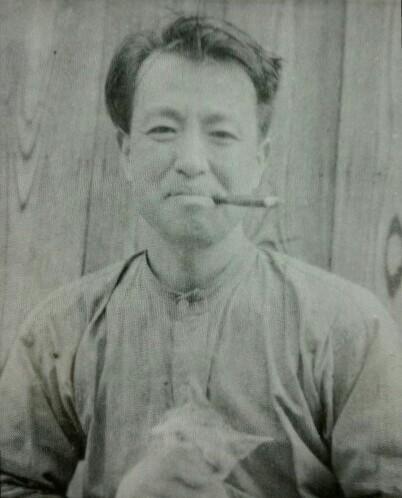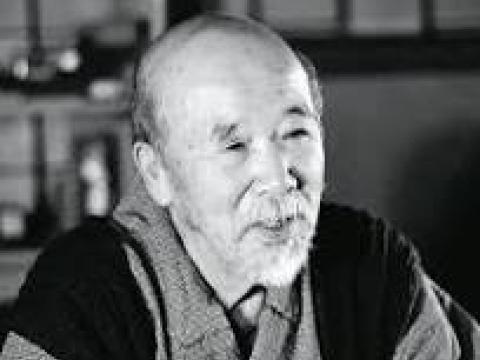A short biography of Japanese anarchist poet Ono Tozaburo

Ono Tozaburo, whose real name was Ono Fujisaburo, was born on the 27th July 1903 in the ward of Minami in the city of Osaka. This city was rapidly industrialising and the emergence of the young working class was accompanied by unrest and the spreading of radical ideas. Born into a wealthy family of merchants, he attended Tenojji Junior High School.
He moved to Tokyo in 1921 and attended the Culture Department of Toyo University. However, like many other Japanese anarchist poets of the time, he dropped out after 8 months.
He started moving towards the anarchist movement and was an admirer of the fiery anarchist Osugi Sakae, murdered by the police with his lover Ito Noe and his little nephew in the aftermath of the Great Kanto earthquake in 1923.
That year he started contributing to the magazine Aka to Kuro (Red and Black) that had been founded not long before by Jun Okamoto(1), Shinjuro Kuwahara, and Shigeharu Sakurai, all anarchist poets. It ran to four issues, January 1923 to June 1924. It was soon shut down by the authorities.
In 1926, along with Jun Okamoto and Kiyoshi Akiyama he launched the magazine Dam-Dam (Trajectory) an anarcho-Dadaist publication . Only one issue appeared. His first collection of poems was rejected by all the publishers he approached, and in the end he had to self-publish his Hanbun Hiraita Mado (A Half-Opened Window). In 1928 he translated and had published Reflections on Violence by Georges Sorel.
In 1930 together with Kiyoshi Akiyama (2) he published the anarchist magazine Dando (Trajectory) which lasted a whole year. He brought out a collection of American proletarian poetry, which he and others had translated, in 1931.
He returned to Osaka in 1933 and wrote poems about the industrial devastation he saw there. In that year he was one of the re-organisers at a national level along with Tai Uelura, Jun Okamoto et Kiyoshi Akiyama, of Kaiko binka renmei (League for a Culture of Liberation) which sought to link the cultural anarchist movement with that of the anarchist workers’ movement, and which published Bungaku tsuhin (New Literatures). He wrote Anarchism and the Literature of the People in that year.
In 1935 he was arrested by the police as a result of the Anarchist Communist Party trial, (see Crump) on the grounds that he was a sympathiser of that group, but was released through lack of evidence. The Japanese State used the Anarchist Communist Party events as an excuse to clamp down heavily on the anarchist movement, and most chose to keep their heads down, including Ono himself. He brought out his poetry collection Osaka in 1939, which addressed itself to the industrial landscapes of Osaka. He also became a literary critic with a radical bent, which proved to be influential.
During World War Two, as members of the Rekitei (Progress) school of poets around the magazine of the same name, founded in 1935, he and Kaneko Mitsuharo were able to get away with publishing anti-war poems.
After the war he opened the Osaka Literature School for Workers in 1954, and he was its principal until 1991.He published The Prosody of Slaves in 1948, where he criticised tanka and haiku lyrics, as a result of various poets like Shigeyoshi Saito praising the war. He opened the Osaka Literature School for Workers in 1954, and he was its principal until 1991, running courses on novels, poetry and children’s literature. He took a leading role in publicising literature and the peace movement. For two years from 1977 he served as President of the Contemporary Poet Committee.
He died in Osaka on 10th October 1996.
(1) Jun Okamoto(1901-1978) Born in Honjo, in Saitama Prefecture. Became interested in anarchism whilst attending Toyo University. In 1947 he abruptly dropped anarchism and turned to Stalinism.
(2) Kiyoshi Akiyama (1904- 1988) Born in the fishing village of Suofu near Kitakyushu ( then called Ogura), where the spirit of mutual aid left a lasting impression on him. In Tokyo,he became a student at Nihon University School, but soon dropped out and moved towards anarchism. Contributed to anarchist poetry magazine Poetry Battle in 1924. Arrested as a result of the Anarchist Communist Party trial. After the war, Akiyama set up People's Poetic Spirit and launched Kosharu Kaneko and Cosmos. He took part in the activities of the Japanese Anarchist Federation, and constantly publicised the role of anarchism in literature, producing works like History of Anarchist Literature whilst addressing himself to his bitter experience during the Second World War. Launched an attack on Jun Okamoto for his Stalinism in 1956.
Nick Heath
Sources:
Crump, John. The Anarchist Movement in Japan, 1906-1996.
Crump, John. The origins of socialist thought in Japan.






Comments